Performance of new R-2 Sensor
. R. Evans, C. R. Hutt, R. N. Nigbor, and T. de la Torre
At the Albuquerque Seismological Laboratory (ASL) we tested 12 new three-axis R2 rotational-velocity sensors made by Eentec to characterize their noise performance (Figures 1 and 2) and amplitude response functions (Figure 3; shortcomings in procedure prevented measurement of phase response).
The R2 is designed for strong-motion seismic and engineering applications and has sensitivity of roughly 50 V/(rad/s) and hard-clip level of about 0.1 rad/s (soft clip levels, where response departs the linear, appear to be about half this value). Their “flat” response band is cited as 0.03 to 50 Hz. The R2 is the company’s successor to the R1 sensor that is deployed in a number of earthquake-prone areas, notably in Taiwan where the R1 has recorded a number of earthquakes well above sensor noise levels. The R2 has lower noise at low frequencies and comparable or higher noise at high frequencies; it is hoped to be less prone to internal corrosion than the R1 because the R2 sensing torus is plastic and less permeable to the corrosive fluid filling it.
We also looked at translation-to-rotation cross axis sensitivity at two frequencies, 1 Hz and 12 Hz. This cross-axis term must be very low in typical seismic and engineering applications because rotation-induced gravitational inputs to horizontal accelerometers (known to contaminate such translational records) are on the order of 1 to 10% of true horizontal translational accelerations during nearby earthquakes. Thus, translation-to-rotation cross axis sensitivity should be under 0.1% in these terms to allow correction of the translational records (that is, rotational velocity integrated to rotation angle and converted to horizontal-acceleration error via gsinθ should be 0.001 or less of true horizontal accelerations). Our 12 examples of the R2 show that this term ranges from 0.00 – 15.4% at these two excitation frequencies, with 31 of the 36 channels tested falling within the 0.1% constraint. While the worst cases seen are inadequate, most channels tested are fine; we conclude that the design is capable of adequate cross-axis performance by this measure but that there are quality control issues. Visual inspection of rotation-to-rotation cross axis yields similar conclusions if constrained to an industry-standard 1% limit. In most cases the cross-cross terms are significant only at high frequencies, which suggests that more rigid support of the sensing tori might reduce these terms further.
Finally, inspection of the sensors as received from the manufacturer revealed generally good construction, a significant improvement over the R1. Most electronic components are now surface-mount style, which is known to be more robust than through-hole. However, some large capacitors are still mounted through-hole and contaminants were present in all 12 devices, commonly including aluminum shavings that can cause electrical shorts (we removed this debris). There was also a white to beige crystalline deposit around most of the plug screws sealing the fluid-filled sensing tori. Two other construction anomalies were also found, a sensing torus with a large bubble and one Z axis oriented upside down to the others (Table 1).
We used ASL’s new Aerotech Inc. rotational shake table, which is highly rigid and has excellent motion control. We used it to inject intervals of constant-frequency sine waves ranging from 0.02 to 50 Hz and recorded the sensor outputs on a Q330 at 200 sps. The output signals were compared to rotation-angle feedback signals recorded by the Aerotech’s controller and converted to rotational velocity during analysis. The failure of phase testing resulted from either variations in the sampling rate of these reference signals or non-uniform rest intervals between sine excitations; this problem will be fixed either by better control of feedback recording or by using fiber optic reference sensors ASL now owns.
To measure self noise, we simply placed the sensors on a basement-attached pier and recorded several hours of output; ambient seismic noise is thought to be well below R2 self noise at this site. About 22 minutes of these noise records were evaluated by the ANSS standard method (Evans et al., SRL, 2010) and are shown in Figure 1. At low frequencies this instrument noise is well below the R1 and at higher frequencies comparable or higher. Overall rms noise levels and other summary information is given in Table 1 and are on the order of 1 – 5 µrad/s rms with a number of exceptions. Four of the sensors have relatively low noise levels on all channels (better than the specified 110 dB below hard clip) in the center of their pass band but not nearer the ends.
Spike-like noise is present on many channels examined over a one-hour interval (Figure 2). A minority of these spikes are large enough and of long enough duration to make an earthquake record useless, but most are of very brief duration, are fairly uncommon in any two-minute record (i.e., typical earthquake duration), and probably can be removed with a linear/nonlinear despiking operation that works well in both small- and large-signal conditions (Evans, BSSA, 1982). Baseline stability (in terms of errors in rotation-corrected horizontal translational displacement) appears adequate for records of several minutes duration.
Amplitude response functions (Figure 3 and Table 1), if first normalized to unity at 4 Hz (sensitivities appear not to have been corrected to any standard value) and if compared over only 0.1 to 20 Hz, are mostly within ±3 dB flatness; some deviate more at frequency extremes within the full pass band of 0.03 to 50 Hz. Even these normalized response functions are not as flat as for most sensors, including that no channels are within ±1 dB of flat (~12% amplitude variation); six of the 36 channels tested exceed the ±3 dB specification even within the limited band of 0.1 to 20 Hz.
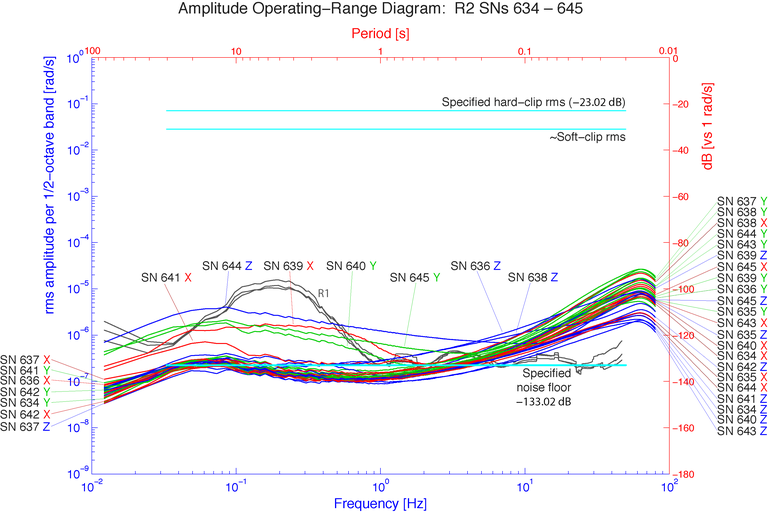
Figure 1. Summary of noise (total rms over half-octave bands) and operating range. No corrections have been made for instrument response so noise referenced to Earth in effect will be rotated somewhat clockwise. Dark gray lines are an example of an R1 noise figure.
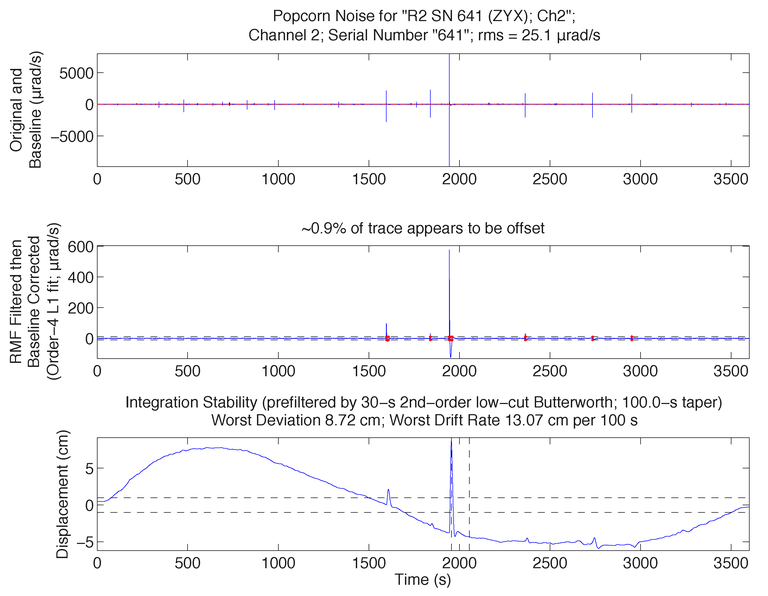
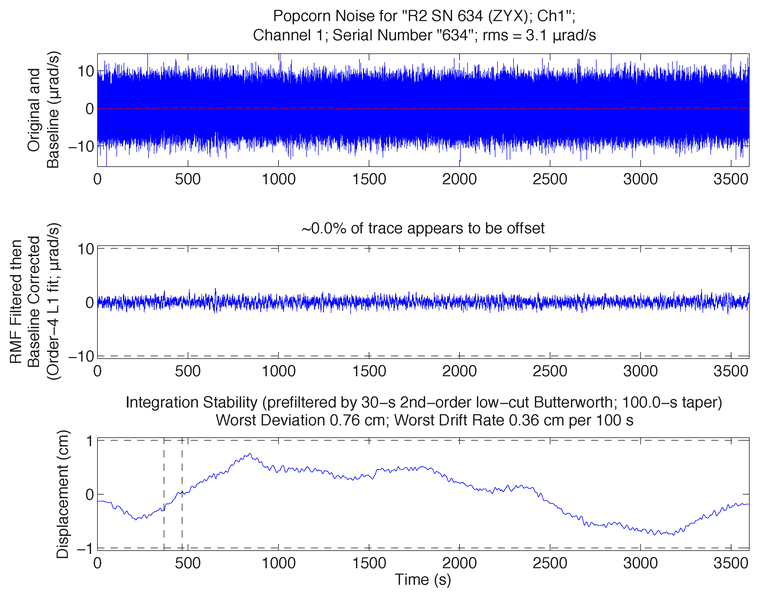
Figure 2. One-hour segments of data showing spikes and baseline stability. (“RMF” means “running median filter”, a nonlinear, approximately one pole low-pass filter that preserves steps and wide spikes while removing narrow spikes.) (Upper set) a poor example, (lower set) a good example. In each set the top panel is raw noise; the center panel is RMF low-pass (marked in red wherever remaining excursions exceed a set threshold); and bottom panel recovers an estimate of instrument noise when applied to recovering gravity-tilt induced errors in horizontal translational accelerometers.
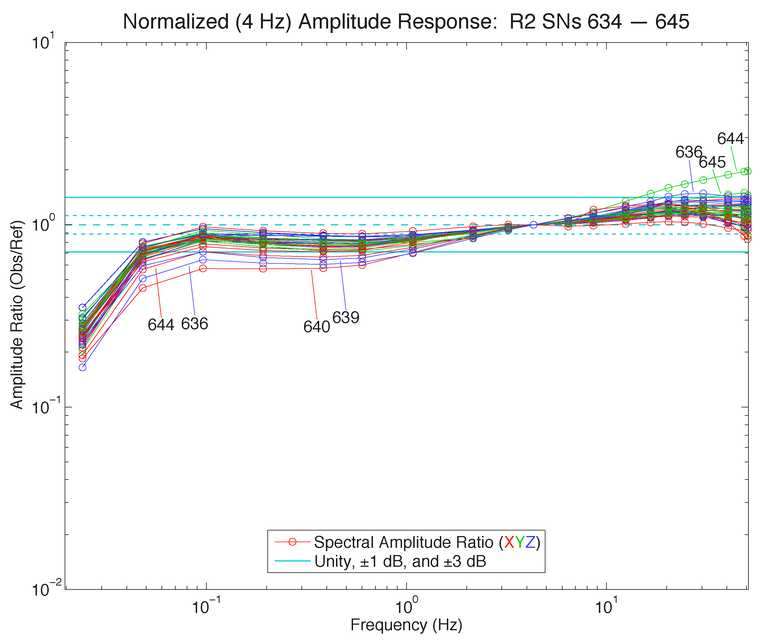
Figure 3. Summary of amplitude response, normalized at 4 Hz to compensate for sensitivity variance.
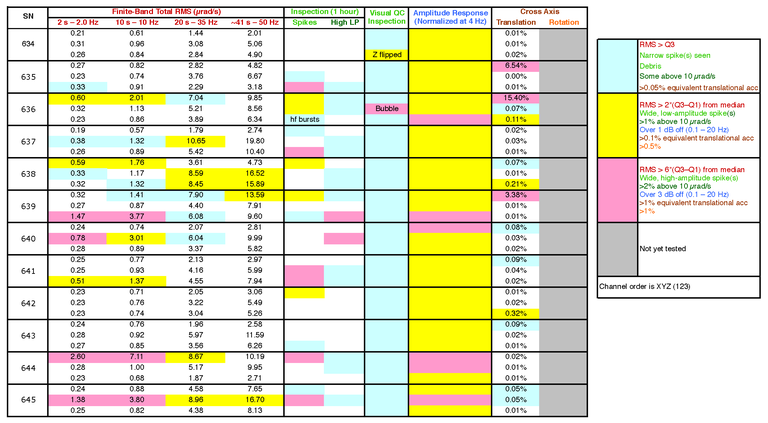
.png)